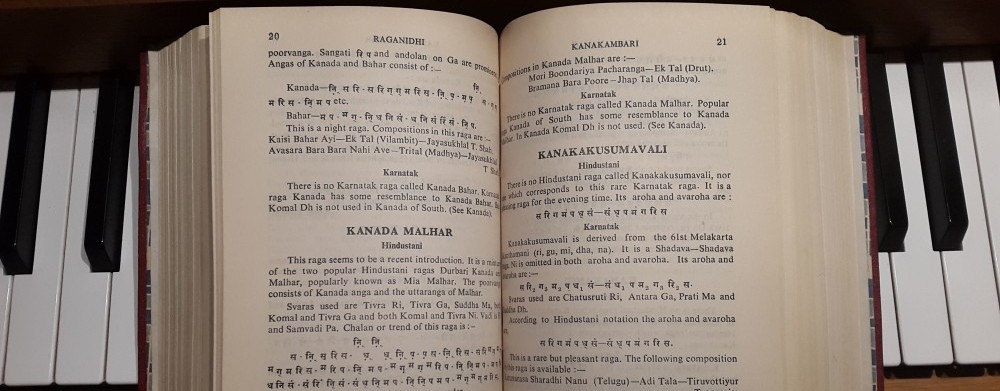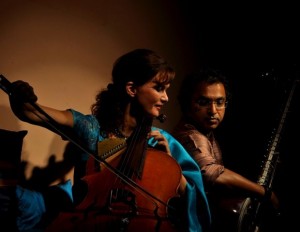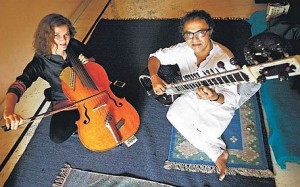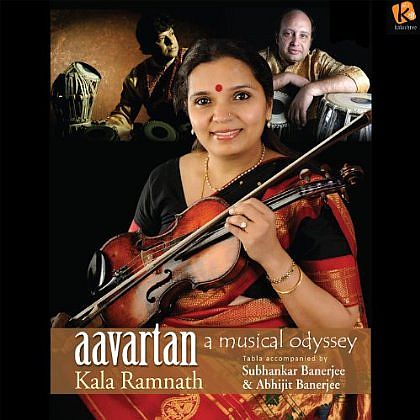
Summer 2012 saw Kala Ramnath‘s latest release Aavartan: A Musical Odyssey, Dawn to Dusk – 1&2. I have many of Kala’s albums and I’m very familiar with her style of playing. Still, I’m pleasantly surprised once more by what Kala has to offer on Aavartan (Cycle). Yes, as expected, her violin sings and sounds magnificent, but what strikes me is the overall depth and maturity of her refined playing, a special treat one can enjoy here for almost two hours! The recordings were done in Mumbai for Kala’s own label Kalashree. The quality of the recordings is excellent, adding up nicely to the listening experience. Kala is supported on tabla by two famous players: Abhijit Banerjee on Dusk to Dawn-1 and Subhankar Banerjee on Dusk to Dawn-2. Both albums contain six ragas, each having a particular connection with a certain time of the day or night, reflecting an ideational system based on a daily cycle of changes that occur in our own body and mind, arousing and stimulating different emotions and moods. In other words: Kala presents 12 ragas for the twenty-four hours of the day according to the time theory in Indian classical music. On Dusk to Dawn-1 Kala plays the raags Bhairav (6-8AM), Jaunpuri (8-10AM), Deshkar (10-12PM), Miya Ki Sarang (12-2PM), Patdeepki (2-4PM) and Din Ki Puriya (4-6PM). On Dusk to Dawn-2 Kala plays Hameer (6-8PM), Jaijaivanti (8-10PM), Shankara (10-12AM), Malkauns (12-2AM), Darbari (2-4AM) and Bhatiyar (4-6AM). For a great listening experience I highly recommend these recordings by the Singing Violin of India!
Category Archives: Gharana / raga music
Kala Ramnath plays her own violin concerto with The Residence Orchestra/The Hague Philharmonic
As part of the Holland-India Festivals The Hague world famous ragaviolinist Kala Ramnath from Mumbai visits The Netherlands to play her own violin concerto, titled The seasons of India, accompanied by The Residence Orchestra/The Hague Philharmonic. The concert will be held at the Conservatory of The Hague on Saturday 10 November 2012. I wonder how Kala’s bending of notes and colourful ragaplaying style combine with the sounds of a symphony orchestra.
I found a clip on YouTube that might give a clue. It shows Kala playing with the London Symphony Strings.
Kala playing with the London Symphony Strings
I portrayed Kala for Radio Netherlands and for the Concertzender. To listen to my radio-portrayal of Kala in 2008, click here.
Excerpt of my video-recording of Kala’s concert at RASA in Utrecht, April 2006
2 Nov.’12 Amsterdam Tropentheater concert tabla legend Zakir Hussain sold out in a beat
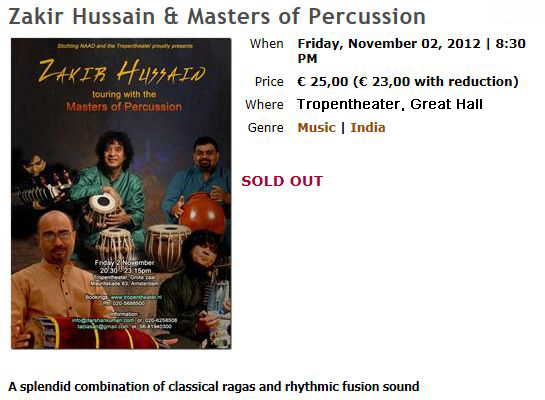
On Friday 2 November 2012 legendary world famous tabla player Zakir Hussain will play with his Masters of Percussion group in the Great Hall of Amsterdam’s Tropentheater. Zakir Hussain will be joined on stage by young brilliant sitar player Niladri Kumar and other great musicians on a variety of instruments including the dholak, ghatam, tabla, kanjira, bansuri and sarangi. For evryone going to the concert it will be a sheer delight to witness the tabla genius playing again in The Netherlands. It will be the third time that I’ll visit a concert of him in Amsterdam. Last time was in 2008 when Zakir Hussain performed with The Masters of Percussion at the Amsterdam India Festival and somewhere in the early nineties (or was it even earlier?) I saw the king of Indian beats performing live on stage in Amsterdam with sarangi player Ustad Sultan Khan. All were memorable great events, due to Zakir’s charisma and overwhelming musical powers. There’s so much said and written about him in books, newspapers, articles and all over the web… what can I add here? Let me just add a quite recent (and quite funny) two-part video-interview with him – shown below – and maybe this one good advise: always book early when Zakir Hussain is playing in your neighbourhood! The concert in Amsterdam I’m going to on 2 November was sold out in a beat. I’m glad I won’t miss one beat of it coming Friday! 🙂
Amelia Cuni’s beautiful interpretation of John Cage’s ‘Solo for Voice 58: 18 Microtonal Ragas’
Early September 2012 I heard (and met) Italian dhrupad singer Amelia Cuni in Göttingen, where she did a concert titled Cosmopolit@n Ragas. It was a beautiful musical event in two parts, starting out with Amelia Cuni’s performance of a raga in traditional dhrupad style. Then she took things in another direction by presenting her dhrupad-styled improvisational skills in a very different musical framework: she performed John Cage‘s Solo for Voice 58: 18 Microtonal Ragas. Here I like to share a beautiful recording of Amelia Cuni interpreting this work of John Cage. Enjoy!
Dhrupad at its finest by Zia Mohiuddin Dagar and Fariduddin Dagar
Great live recording, Moses & Aaron Church, Amsterdam, 1985
Zia Mohiuddin Dagar on rudra veena, marvellous playing and recording
Great 1965 recording of the (Senior) Dagar Brothers – Raga Desi
N. Rajam’s great ‘gayaki’ on violin – Raag Malkauns
Violin icons of East & West meet up: Kala Ramnath and Hilary Hahn
A meeting up of world famous violin players from different classical traditions is not an evryday phenomenon. Recently it happened to Hindustani classical (raga) performer Kala Ramnath and Western classical player Hilary Hahn. Kala wrote a piece for Hilary and in this video she explains a few basics of raga music and about the piece she’s done for Hilary.
Wonderful concept for an enhanced experience of raga music: The Silence Concert
To help people experience the power of Indian classical music, married and musical couple cellist Saskia Rao de Haas and sitarist Shubhendra Rao started the Silence Concert movement, to experience music in its purest form: surrounded by silence. An intriguing, fascinating concept.
Saskia and Shubhendra explained their initiative in The Hindu of 19 September 2012 and here’s what they have to say about it on the Silence Concert Facebook-page they created:
“What is a Silence Concert?
For the sensitive listener, there can be a big difference in attending a concert and experiencing music. The effect that music can have on our lives, especially Indian music, is often lost by the social conventions that prevail at concerts: applause, talking before and after the concert, ceremonies, all of which take the attention away from the music itself. To help people experience the magical power of Indian music in a concert setting, Pt Shubhendra Rao and Saskia Rao initiated the Silence Concerts movement. In a Silence Concert the only sound that reverberates is music. There are no introductions, ceremonies, gimmicks, talks, speeches or applause. The setting is serene, beautiful and set up to experience beauty within through the pure experience of music. Through controlling external influences that can distract listener and performer the experience of pure music is enhanced.
Entering the auditorium for a Silence concert, the audience and artists leave behind their worries and daily masks, because they do not have to respond in word or gesture to the outside world. They can be gently led through a sublime journey within. What follows is that their experience turns within. The artist can share his music without playing to the gallery and the effect lingers after the concert, not interrupted by applause.
Abhinavagupta (approx. 950-1020 AD), the Indian philosopher, said that the ‘perfect audience is a spotless mirror of the performer’. Audience and performer become one in a Silence concert. The social context is taken out and the audience is left with a truly introspective experience, as is the performer.” (Saskia Rao de Haas and Shubhendra Rao)
Saskia and Shubhendra end with a quote of Sufi Inayat Khan (1882-1927):
“While tuning the tanpura, the artist tunes his own soul. Not only has he tuned the instrument, but he has felt the need of every soul in the audience and the demands of their souls, what they want at that time. He becomes an instrument of the whole cosmic system, open to all inspiration at one with the audience, in tune with the tanpura and it is not only music, but spiritual phenomena that he gives to the people…‘ The object of Indian music is the training of the mind and the soul, for music is the best way of concentration. If one only knows how to appreciate it and give one’s mind to it, keeping all other things away, one naturally develops the power of concentration. Besides the beauty of music, there is the tenderness, which brings life [and gratitude] to the heart. For the person of fine feelings life in this world is very trying. It is jarring and it sometimes has a freezing effect. It makes the heart, so to speak, frozen. If one can focus one’s heart on music, it is just like warming up something that was frozen. The joy of life depends upon the perfect tuning of mind and body.”
Perhaps new opportunities for raga playing… pianists?
For those who (keep trying to) play ragas on a piano – but do they play ragas? I don’t think so – perhaps for them this ‘fluid’ piano opens up new opportunities in regard to the use of different tunings, but also in regard to pitch shifting or bending the notes during playing. 🙂
